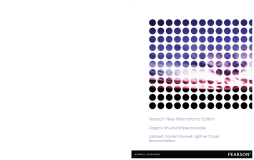
BOOK
Organic Structural Spectroscopy: Pearson New International Edition
Joseph B. Lambert | Scott Gronert | Herbert F. Shurvell | David Lightner | Robert Graham Cooks
(2013)
Additional Information
Book Details
Abstract
Chapter 1 Introduction
1-1 The Spectroscopic Approach to Structure Determination
1-2 Contributions of Different Forms of Spectroscopy
1-3 The Electromagnetic Spectrum
1-4 Molecular Weight and Molecular Formula
1-5 Structural Isomers and Stereoisomers
Problems
Part I NUCLEAR MAGNETIC RESONANCE SPECTROSCOPY
Chapter 2 Introduction
2-1 Magnetic Properties of Nuclei
2-2 The Chemical Shift
2-3 Excitation and Relaxation
2-4 Pulsed Experiments
2-5 The Coupling Constant
2-6 Quantification and Complex Splitting
2-7 Commonly Studied Nuclides
2-8 Dynamic Effects
2-9 Spectra of Solids
2-10 Experimental Methods
Problems
Tips on Solving NMR Problems
Bibliography
Chapter 3 The Chemical Shift
3-1 Factors That Influence Proton Shifts
3-2 Proton Chemical Shifts and Structure
3-3 Medium and Isotope Effects
3-4 Factors That Influence Carbon Shirts
3-5 Carbon Chemical Shifts and Structure
3-6 Tables of Chemical Shifts
Problems
Further Tips on Solving NMR Problems
Bibliography
Chapter 4 The Coupling Constant
4-1 First-Order Spectra
4-2 Chemical and Magnetic Equivalence
4-3 Signs and Mechanisms
4-4 Couplings over One Bond
4-5 Geminal Couplings
4-6 Vicinal Couplings
4-7 Long-Range Couplings
4-8 Spectral Analysis
4-9 Second-Order Spectra
4-10 Tables of Coupling Constants
Problems
Bibliography
Chapter 5 Further Topics in One-Dimensional NMR
5-1 Spin-Lattice and Spin-Spin Relaxation
5-2 Reactions on the NMR Time Scale
5-3 Multiple Resonance
5-4 The Nuclear Overhauser Effect
5-5 Spectral Editing
5-6 Sensitivity Enhancement
5-7 Carbon Connectivity
5-8 Phase Cycling, Composite Pulses, and Shaped Pulses
Problems
Bibliography
Chapter 6 Two-Dimensional NMR
6-1 Proton-Proton Correlation Through Coupling
6-2 Proton-Heteronucleus Correlation
6-3 Proton-Proton Correlation Through Space or Chemical Exchange
6-4 Carbon-Carbon Correlation
6-5 Higher Dimensions
6-6 Pulsed Field Gradients
6-7 Summary of Two-Dimensional Methods
Problems
Bibliography
Part II MASS SPECTROMETRY
Chapter 7 Instrumentation and Theory
7-1 Introduction
7-2 Ionization Methods
7-3 Mass Analysis
7-4 Sample Preparation
Chapter 8 Ion Activation and Fragmentation
8-1 Basic Principles
8-2 Methods and Energetics
8-3 Functional Groups
Chapter 9 Structural Analysis
9-1 Molecular Weights
9-2 Molecular Formula
9-3 Structures from Fragmentation Patterns
9-4 Polymers
Chapter 10 Quantitative Applications
10-1 Quantification of Analytes
10-2 Thermochemistry
Part III VIBRATIONAL SPECTROSCOPY
Chapter 11 Introduction
11-1 Introduction
11-2 Vibrations of Molecules
11-3 Infrared and Raman Spectra
11-4 Units and Notation
11-5 Infrared Spectra: Dispersive and Fourier Transform
11-6 Sampling Methods for Infrared Transmission Spectra
11-7 Raman Spectroscopy
11-8 Raman Sampling Methods
11-9 Depolarization Measurements
11-10 Infrared Reflection Spectroscopy
Problems
Bibliography
Chapter 12 Group Frequencies
12-1 Introduction
12-2 Factors Affecting Group Frequencies
12-3 Infrared Group Frequencies
12-4 Raman Group Frequencies
12-5 Preliminary Analysis
12-6 The CH Stretching Region (3340-2700 cm-1)
12-7 The Carbonyl Stretching Region (1850-1650 cm-1)
12-8 Aromatic Compounds
12-9 Compounds Containing Methyl Groups
12-10 Compounds Containing Methylene Groups
12-11 Unsaturated Compounds
12-12 Compounds Containing Oxygen
12-13 Compounds Containing Nitrogen
12-14 Compounds Containing Phosphorus and Sulfur
12-15 Heterocyclic Compounds
12-16 Compounds Containing Halogens
12-17 Boron, Silicon, Tin, Lead, and Mercury Compounds
12-18 Isotopically Labeled Compounds
12-19 Using the Literature on Vibrational Spectroscopy
Problems
Bibliography
Part IV ELECTRONIC ABSORPTION SPECTROSCOPY
Chapter 13 Introduction and Experimental Methods
13-1 Introduction
13-2 Measurement of Ultraviolet-Visible Light Absorption
13-3 Quantitative Measurements
13-4 Electronic Transitions
13-5 Experimental Aspects
Problems
Bibliography
Chapter 14 Structural Analysis
14-1 Isolated Chromophores
14-2 Conjugated Chromophores
14-3 Aromatic Compounds
14-4 Important Naturally Occurring Chromophores
14-5 The Woodward-Fieser Rules
14-6 Steric Effects
14-7 Solvent Effects and Dynamic Equilibria
14-8 Hydrogen Bonding Studies
14-9 Homoconjugation
14-10 Charge Transfer Band
14-11 Worked Problems
Problems
Bibliography
Chapter 15 Integrated Problems
